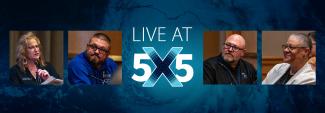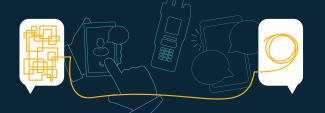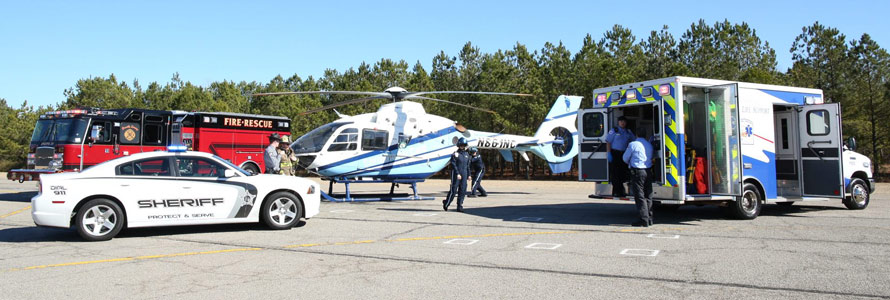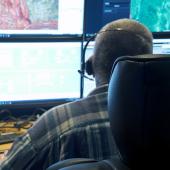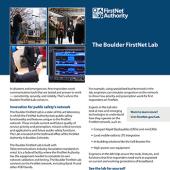Summary
The Saint Louis region is home to 88 municipalities across 523 square miles. For public safety officials in this area of Missouri, interoperability is key. To meet this need, the Clayton Fire Department is using FirstNet to connect to other first responders, access data on the scene of incidents, and enhance situational awareness and patient care.
Guest
Kyle Richardson
FirstNet Authority Senior Public Safety Advisor
Chief Richard Carrizzo
Southern Platte Fire Protection District, Missouri
Chief John Paul Jones
Clayton Fire Department, Missouri
Transcript
Preview
Narrator: You're listening to Public Safety First, a podcast to help you learn about the First Responder Network Authority and how you can be part of the future of public safety technology.
And now, your host.
Kyle Richardson: Good morning. Welcome to the Public Safety First podcast. I’m Kyle Richardson of the FirstNet Authority.
Chief Richard Carrizzo: And I’m Richard Carrizzo, Fire Chief of Southern Platte Fire Protection District and board member for FirstNet Authority.
Kyle Richardson: We’re joined today by Chief John Paul Jones of the Clayton Fire Department. How you doing, John?
Chief John Paul Jones: Doing good, thank you.
Narrator: You're listening to Public Safety First, a podcast to help you learn about the First Responder Network Authority and how you can be part of the future of public safety technology.
And now, your host.
Kyle Richardson: Good morning. Welcome to the Public Safety First podcast. I’m Kyle Richardson of the FirstNet Authority.
Chief Richard Carrizzo: And I’m Richard Carrizzo, Fire Chief of Southern Platte Fire Protection District and board member for FirstNet Authority.
Kyle Richardson: We’re joined today by Chief John Paul Jones of the Clayton Fire Department. How you doing, John?
Chief John Paul Jones: Doing good, thank you.
Chief Richard Carrizzo: Good morning, John Paul. I know that you spent a little over 30 years in the Kansas City, Kansas Fire Department, and, upon your retirement, still wanted to stay in the service, and so you decide to change states a little bit and move over to the east side of Missouri, into the city of Clayton, where you’ve been fire chief for the last couple of years.
Tell me a little bit what’s going on, in Clayton, for our listeners. A little bit about the city, and what it’s like to be in a suburb of St. Louis, and how, maybe, your technology’s changed a little bit from that city compared to KCK [Kansas City, Kansas].
Chief John Paul Jones: Well, I’ll tell you there’s a lot of similarities between the two metro areas. You know, St. Louis metro, I think, you know, including some of the parts of the metro that are in Illinois, there’s like 2.8 million population, which, you know, that’s a huge area. You look at just St. Louis County, separate from the Illinois side in St. Louis City—you’re looking at 88 municipalities, 523 square miles, a population of about 996,000 people. So, you can imagine with multiple PSAPs [public safety answering points] and 43 different fire departments, the challenges as far as interoperability and communications. Not to mention all of the different law enforcement agencies involved with all those municipalities combined. Things are so much more complicated, and the interoperability between law enforcement and the fire service is vital in all the different areas. I mean, we’ve seen anything from natural disasters to, quite frankly, you know, unfortunately, the active assailant scenarios that may involve multiple agencies across public safety. And the extreme importance of interoperability in relation to bringing those types of activities to resolution.
Chief Richard Carrizzo: So, John Paul, why don’t you discuss a little bit of how Clayton decided to invest into FirstNet, and kind of why that took place, and how it affected the firefighters and the crew members.
Chief John Paul Jones: If you look at, you know, the multiple PSAPs and the multiple fire departments and jurisdictions that have to come together through automatic aid, you know, it becomes a very complicated system that can be made simple through interoperability. So, having the ability to have the coverage necessary, to have the reliability of that network, to have a multifaceted approach, not just through land mobile radio but also through voice over LTE [long term evolution], you know, essentially the ability also to transmit data. Clayton is a very dense area. There’s approximately 44 high-rise buildings that combine with residential and retail but we’re surrounded by all these other communities, so we have to come together for that type of response. So, having the FirstNet capability to be able to transmit this large amounts of data that we need for these preplans so that these operations can be very effective, you know.
Chief Richard Carrizzo: Have you seen a big increase in coverage since going to FirstNet? And then, with that, have the firefighters seen any type of difference or anything you can share with our viewers of how it may help them in the future?
Chief John Paul Jones: Yes. there’s a big difference, and I’ve seen it firsthand, between the FirstNet coverage and some of the other carriers that aren’t FirstNet. And of course, there’s only one FirstNet. But yeah, we’ve experienced additional coverage ability not just within Clayton, but, you know, throughout St. Louis County because of the automatic aid. We’re more reliant than ever on each other, and especially in a all-hazards environment. But one thing that’s interesting it’s that, right now there’s a lot of third-party apps out there that are being used, but in the FirstNet ecosystem, what’s really exciting is that these vetted out, secure apps that are going to be available within this ecosystem as this system progresses and the buildout happens, I think, are really going to make a difference, and be game changers. But, some of those third-party apps that are being used, you know, when it comes to notification and response to incidents, this notification’s taking place before the alarm goes off in the fire station, and they have the ability to decrease their response times through the use of this, and what are they using to transmit that LTE data? It’s FirstNet.
Kyle Richardson: So, I’m glad you mentioned that. Currently, on the FirstNet App Catalog, there are over a hundred-plus public safety applications available to first responders, so those applications, those innovations are available today, as well as the device ecosystem – there’s hundreds of devices available to public safety from your cell phone to a router, modem, there’s wearables, that ecosystem is continuing to blossom and grow. So, as I mentioned earlier, you both are true advocates for the future of technology, but, more importantly, its impact for public safety. What are some of the new innovations you’re seeing in the fire service that’s impacting the way you do your jobs?
Chief John Paul Jones: Well, I think what’s interesting is looking at how we handle the need for having an increase in what I would call intelligence information on the scene. You know, I ran a, in 2008, ran a million gallons of gasoline on fire at a tank farm, and what was interesting is, we had to get a beat on whether or not the lid was intact on this huge above-ground gasoline storage tank in order to understand whether we were going to let this thing burn out, or are we going to have to put it out and deal with it. Because there was a possibility that this tank could rupture, and of course, you know, having a million gallons of gasoline and all the vapor and expansion you know, could have been a very dangerous situation. So, the decision was made to let this thing burn, but we had to know what that lid looked like, and we didn’t have the capability. There weren’t any drones back then or whatever, so. But, I was also, because of the, you know, the fire and the smoke and the visibility issue, it was right next to the downtown airport, and I had to close the airport, but before I did, I had to let a news helicopter fly over to give us a visual, and then we were seeing the feed from the TV networks so we could see the lid, and it was intact. And then immediately I closed the airport. But fast forward to today. Think of the capabilities I could have had, the recon and gain that intelligence and that information in order to mitigate that scene. Now, I was lucky, in that regard, to be able to do what I did. But that capability now is concrete, it exists, and, readily available.
Kyle Richardson: So, Chief Jones, Clayton is a suburb with several high rises. And you talked about interest in helping to solve the z-axis — what we call as the holy grail for firefighters. What location information do you find more important for your operations, and what are the biggest bottlenecks or pain points that you face regarding location-based service while performing your duties?
Chief John Paul Jones: Well, I mean, accountability. The accountability issue in the fire service is everything. Of course, when you say it’s the holy grail, it’s because knowing which division and floor somebody’s on, as well as where they’re located, you know, if I’m in the northwest corner, you know, it, that kind of information doesn’t do me any good if I don’t know what floor they’re on in a 35-story building. So, having that capability will be everything. When I look back and some of the line-of-duty deaths, you know, brave firefighters that have died in the line of duty, because we did not have that type of technology, the inability to locate them quickly and get them out of that situation. I think this will provide for that. This will make for a much safer fire ground operations and safety, and I think it will reduce the risk associated with these activities.
Kyle Richardson: Chief Carrizzo, your agency is demoing the FirstNet Push-to-Talk?
Chief Richard Carrizzo: Correct.
Kyle Richardson: In your mind, how will that capability enhance or supplement what you’re doing today with radios?
Chief Richard Carrizzo: Well, it is very exciting, both as a fire chief and a First Responder Network Authority Board member, to watch this really coming alive is very exciting. I know FirstNet AT&T will be providing what was known as the mission-critical push-to-talk. It is, it’s the first step in the process. In my own organization, it was an honor to be one of the beta testers. Also, FirstNet lab in Boulder, they’re going to continue to monitor that and test and provide feedback back to FirstNet AT&T to make the system even better for the push-to-talk. Our agency—how we see it being operated at the beginning, this kickoff will be more for administrative activities. All our pumpers will have it, so the captain will carry a FirstNet phone still and use the push-to-talk when needed and not be on the radio. So, we’re going to slowly implement that system into how it would be used on the radio, but when you don’t need to be tying up airwaves and we can use it for other things.
Kyle Richardson: What features or functions are needed before you, and this is a question for both of you, are willing to utilize a broadband push-to-talk solution in your mission?
Chief John Paul Jones: I mean, it’s all about Band 14, you know. Band 14 gives you that coverage. Band 14 gives you that reliability. When you look at these large, metropolitan areas, I mean, there was a train derailment in Dupo, Illinois, outside the St. Louis area. You had 13 rail cars that derailed during that incident. And you had some hazardous materials that were causing exposure, they were closing schools, but the ability to communicate on scene and use these two platforms simultaneously for data, for voice over LTE, for voice over land mobile radio, I believe just enhances your capabilities in a large incident. And we’re finding that there’s a lot of other data, a lot of other information that has to be communicated that can be done on this other platform.
Kyle Richardson: So, we’re talking about the enhanced capabilities that FirstNet is providing. How do you see FirstNet’s role in improving patient outcomes?
Chief John Paul Jones: Well, you know, it’s interesting, I just read an article the other day about Junction City Fire Department, which is a midsize city in central Kansas, and how they’re using that to affect patient care outcomes—how they’re using FirstNet, and their ability to communicate with the hospital, because they service a pretty good size rural area, just outside of Junction City as well. And so these long distance transports to Topeka, I mean you know, 45-minute transports, you know, having that live, real-time capability to transmit this patient care data, so that the prehospital care can couple with the hospital care without any sort of delay. They’re ready for them, they’re advising the crews en route, involving this long-distance patient care, because that’s a different setting, you know. When you have a two-minute response time to the hospital, you know, in an urban environment, two, three, four minutes that’s a different world than when you have this 45-minute transport from a rural area.
Kyle Richardson: And so, how do you in Clayton see that technology helping you out?
Chief John Paul Jones: Well, you know, in Clayton, it’s the city. It’s in a large metropolitan area, city within a city, you know, basically. So for patient care involving what we do and those shorter duration transports, it’s still absolutely critical and vital because as they say with cardiac patients, time is muscle. So for STEMI patients, and STEMI is, you know, the ST-Elevated Myocardial Infarction, which means heart attack, okay, so where data from the advanced cardiac monitors onboard an ambulance would transmit this data via wireless LTE to the destination hospital provider. This use of technology affords us the ability to communicate relevant, critical patient information, and, you know, that data, interpreted by the ER [emergency room] physicians in real time, where they can advise us en route and also get ready for that patient’s arrival at the hospital.
Kyle Richardson: So, where do you see the next generation – what is your vision based on your operational experience?
Chief John Paul Jones: I’m looking forward to what’s in the future, but I got to tell you, in a lot of ways, the future is now, and the capabilities, there are a lot of capabilities that exist out there, and we need to embrace them in public safety. But I’m excited about it, I’m excited about what that means for Clayton, what that means for the St. Louis Metropolitan area, and, quite frankly, public safety across the United States, so, thank you, for doing this.
Chief Richard Carrizzo: I’d just like to add on. We cannot forget that this is about public safety. It’s about all of public safety, not just fire or PD [police departments] — it’s about everybody, and everybody’s input to continue to build the system that we all want, and not what somebody else thinks that we want. It’s about what the people on the ground want, all the way up to the chief officers — what they need and what they want, and that’s what we need to keep listening to them and build a system for them.
Kyle Richardson: Well, thanks a lot, guys. As we close the podcast, I just want to thank you both for what you do and I look forward to continuing to work with you.
Chief John Paul Jones: Thank you very much, I appreciate it.
Chief Richard Carrizzo: Thank you, John Paul, for being here, and participating in our podcast today.
Chief John Paul Jones: Thanks a lot.
Narrator: Thanks for listening today. We're excited to have you join our podcast community. Make sure to subscribe on iTunes, SoundCloud, and YouTube. You can learn more about the First Responder Network Authority at FirstNet.gov and learn about FirstNet products and services at FirstNet.com.



